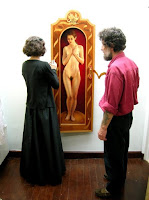The elephant in the shroom
THE DRUG ISSUE: It's time to start being realistic about magic mushrooms
By Ari Messer

DRUG LIT The psychedelic experience is perfectly, if unintentionally, expressed in a poetry collection: Too long I took clockwork as a model instead of following the angle my inclinations make with the ground. So writes Rosmarie Waldrop in A Key into the Language of America (New Directions, 1994), a book based on Rhode Island founder Roger Williams's 1643 guide of the same name. The most "meditative" poets, from Milton and Blake to James Merrill and Denise Levertov, are often those who have reworked historical texts. The same could be said about scholars of psychedelics. Forget about Aldous Huxley's exaggerated diatribes and everything by Carlos Castenada. The "doors of perception" aren't opened by self-indulgent rambles of the "I'm a spiritual person" variety.
In 2007, sick of the ingrained pop mythologies surrounding psychedelics (and realizing, it seems, that such pseudoscience isn't helping make the case for legalization), British scholar Andy Letcher published Shroom: A Cultural History of the Magic Mushroom (Harper Perennial, 384 pages, $14.99). Though he spends quite a bit of time debunking myco-myths that I'd imagine are only actually believed by people while tripping — Santa Claus is a giant, speckled variety of the Amanita genus; Stonehenge was like a Dead show without the music — the double-PHD Letcher gives a solid sense of magic mushrooms as they moved through history, and we moved with or tripped over them. Letcher uncovers how little we can possibly know.
Because mushrooms can "simply be picked and eaten," Letcher explains, there is "not a single instance of a magic mushroom being preserved in the archaeological record anywhere." Drugs and apparent representations of magic mushrooms that have been found have had other, nonintoxicating uses, from food to insulation, or have been doctored up to appear trippy, as with one example of Neolithic rock art widely distributed through self-declared visionary Terence McKenna's books — McKenna's then-wife, Kat Harrison, actually made the drawing from a photo, adding her own interpretation.
I once heard prankster Paul Krassner relate the tale of his first psychedelic escapade. After his mind returned, he said, it seemed like a good idea to call his mother and express his elation (the rational part of his mind must have still been distracted). Her hilarious response was perhaps culled from the jumbled logic of the war on drugs: "Watch out," she pined into the phone. "I've heard that LSD can be a gateway drug to ... marijuana!"
Letcher shares this realistic sense of humor about the life of drugs. Before picking apart proponents of the otherworldly "ancient mushrooming thesis," he offers them room to breathe. He is ultimately interested in the cultural evolution of the West's "yearning for enchantment" in response to changes that have occurred since the industrial revolution. "That we in the West have found value in those remarkable mushroom experiences, where almost all others before us have regarded them as worthless," he notes, "means that in a very real sense we could claim to be living in the Mushroom Age." He explores how McKenna's death in 2000 left the psychedelic movement without an "obvious figurehead" and how the need to paste our modern sensibilities onto "a pre-historic religion or tabu" (as shroom-popularizer Gordon Wasson wrote in a letter to Robert Graves in 1950), is just an urge.
Post-McKenna, what is the destination of the psychedelic movement's next trip? A new book, Mushroom Magick (Abrams, 144 pages, $19.95), is respectable for its clear motivations and gorgeous, thorough design. It's a little too much fun, consisting of over 100 lush, full-page watercolors by Arik Roper, whose shrooms "grow from the tip of my pen without much effort." Incomplete but clear field notes by Gary H. Lincoff and an essay by Erik Davis offer tasty morsels, and the short bibliography points to useful resources such as Paul Stamets' field guides. But Daniel Pinchbeck's foreword follows the same trajectory that Letcher so carefully deconstructs. I'm afraid that Mushroom Magick ultimately presents as recreational something that, with or without New Age revisionism, clearly has a deeper, revelatory role to play in human affairs. And that's not furthering the discussion, that's a little irresponsible.





